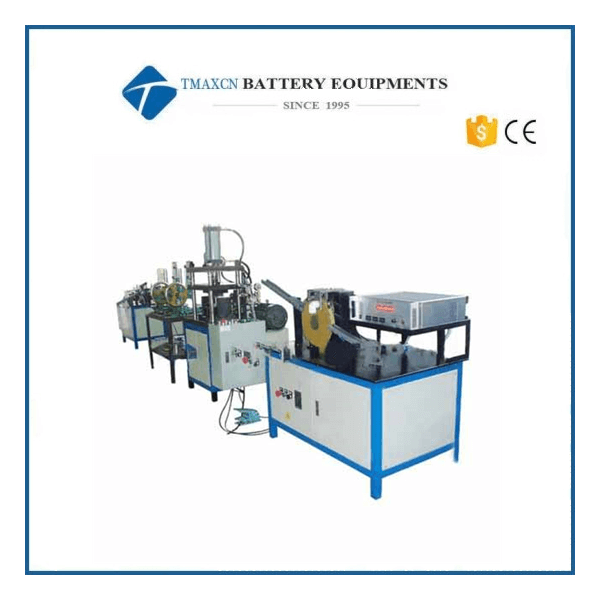مدونة الموقع
اتصل بنا
- إذا كانت لديك أسئلة، يرجى الاتصال بنا، وسيتم الرد على جميع الأسئلة
- البريد الإلكتروني : David@tmaxcn.com
- البريد الإلكتروني : Davidtmaxcn@gmail.com
- إضافة : No. 39, Xinchang Road, Xinyang, Haicang Dist., Xiamen, Fujian, China (Mainland)
المنتجات الساخنة
Xiamen Tmax Battery Equipments Limited was set up as a manufacturer in 1995, dealing with lithium battery equipments, technology, etc. We have total manufacturing facilities of around 200000 square foot and more than 230 staff. Owning a group of experie-nced engineers and staffs, we can bring you not only reliable products and technology, but also excellent services and real value you will expect and enjoy.
A supercapacitor assembly machine is a specialized piece of equipment designed to automate and streamline the assembly process of supercapacitors. This machine plays a critical role in ensuring precision, consistency, and efficiency during the manufacturing of these advanced energy storage devices. By handling delicate components such as electrodes, separators, current collectors, and housings, the assembly machine ensures that each supercapacitor meets strict quality standards.
In this article, we will explore the structure, functionality, advantages, challenges, and innovations associated with supercapacitor assembly machines.
●What Is a Supercapacitor Assembly Machine?
A supercapacitor assembly machine is an automated or semiautomated system that integrates various processes required to assemble supercapacitor cells. These machines are designed to handle sensitive materials and perform tasks such as stacking, winding, sealing, and housing insertion with high precision and minimal human intervention.
The primary goal of the assembly machine is to improve production efficiency while maintaining consistent quality across all manufactured units.
●Key Components of a Supercapacitor Assembly Machine
A typical supercapacitor assembly machine consists of several key components:
1. Material Feeding System
Supplies electrodes, separators, current collectors, and other raw materials to the assembly line.
Ensures proper alignment and positioning of components for subsequent processes.
2. Stacking/Winding Mechanism
Stacks flat electrode layers with separators for prismatic cells or winds them into cylindrical configurations.
Achieves precise alignment and uniform spacing between layers to optimize performance.
3. Sealing Unit
Seals the assembled cell within its housing using techniques such as heat sealing, laser welding, or ultrasonic welding.
Ensures hermetic integrity to prevent electrolyte leakage or contamination.
4. Housing Insertion System
Places the stacked or wound electrode assembly into a prefabricated housing or casing.
Aligns the assembly accurately to avoid misalignment or damage.
5. Tab Welding Station
Attaches current collector tabs to the electrodes using resistance welding, ultrasonic welding, or laser welding.
Ensures strong electrical connections without compromising the structural integrity of the cell.
6. Vision Inspection System
Uses cameras and sensors to inspect components at various stages of assembly.
Detects defects, misalignments, or contaminants in realtime and triggers corrective actions.
7. Automation and Control Systems
Integrates programmable logic controllers (PLCs), robotics, and software to coordinate all machine operations.
Enables customization of parameters for different cell designs and chemistries.
●Processes Performed by a Supercapacitor Assembly Machine
The assembly machine performs the following critical processes:
1. Electrode Preparation
Handles precut electrodes and attaches current collector tabs for efficient electrical connection.
2. Core Assembly
Combines electrodes and separators into a core assembly through stacking or winding techniques.
3. Housing Integration
Inserts the core assembly into a housing or casing, ensuring proper alignment and secure placement.
4. Sealing
Seals the housing to create a hermetic barrier against external contaminants and internal electrolyte leakage.
5. Quality Control
Conducts realtime inspections to verify dimensions, alignment, and overall quality of the assembled cell.
●Advantages of Using a Supercapacitor Assembly Machine
1. Improved Precision:
Automated systems ensure accurate alignment and placement of components, reducing defects and improving performance.
2. Increased Efficiency:
Faster production rates compared to manual assembly, enabling higher throughput and reduced labor costs.
3. Consistent Quality:
Eliminates variability caused by human error, ensuring uniformity across all manufactured units.
4. Cost Savings:
Reduces material waste and rework due to precise handling and realtime quality checks.
5. Scalability:
Can be configured for smallscale prototyping or largescale mass production, depending on demand.
6. Safety Enhancements:
Minimizes human exposure to hazardous materials like electrolytes and sharp components.
●Challenges in Supercapacitor Assembly Machines
Despite their benefits, supercapacitor assembly machines face certain challenges:
1. Complexity of Operations:
Handling delicate materials such as thin electrodes and porous separators requires advanced engineering solutions.
2. Material Compatibility:
Ensuring compatibility between various materials (e.g., current collectors, separators, and housings) during assembly can be challenging.
3. High Initial Costs:
Advanced automation and precision machinery come with significant upfront investment.
4. Maintenance Requirements:
Regular calibration and maintenance are necessary to ensure optimal performance and avoid downtime.
5. Adaptability to New Technologies:
Rapid advancements in supercapacitor materials and designs require frequent upgrades to keep assembly machines uptodate.
Button Super Capacitor Automatic Production Line
●Innovations in Supercapacitor Assembly Machines
To overcome these challenges and enhance productivity, manufacturers are incorporating cuttingedge technologies into assembly machines:
1. Advanced Sensors and Vision Systems:
Realtime monitoring of component alignment, sealing quality, and overall assembly ensures consistent output.
2. AI and Machine Learning:
Predictive analytics optimize machine performance, detect anomalies, and improve yield rates.
3. Modular Design:
Flexible systems allow for easy reconfiguration to test new materials, chemistries, and cell designs.
4. Sustainability Features:
Ecofriendly practices minimize waste and energy consumption during the assembly process.
5. SolidState Adaptation:
Future machines will be designed to handle solidstate electrolytes, enabling safer and more efficient nextgeneration supercapacitors.
6. Collaborative Robotics:
Humanmachine collaboration enhances flexibility and adaptability in assembly processes.
●Applications of Supercapacitor Assembly Machines
Supercapacitor assembly machines are used in a wide range of industries, including:
1. Consumer Electronics:
Produces compact supercapacitors for smartphones, wearables, and portable devices.
2. Automotive Industry:
Manufactures highpower supercapacitors for hybrid and electric vehicles, regenerative braking systems, and auxiliary power units.
3. Renewable Energy:
Creates durable supercapacitors for energy storage applications in solar panels, wind turbines, and grid stabilization systems.
4. Industrial Equipment:
Generates robust supercapacitors for heavy machinery, cranes, elevators, and other industrial applications.
5. Medical Devices:
Develops reliable supercapacitors for implantable devices, diagnostic tools, and wearable health monitors.
●The Future of Supercapacitor Assembly Machines
As the demand for advanced energy storage solutions grows, supercapacitor assembly machines will continue to evolve. Key trends shaping the future include:
1. Increased Automation:
Fully autonomous systems will further boost production speeds and reduce costs.
2. Customization Options:
Modular designs will enable manufacturers to tailor machines for specific cell types and chemistries.
3. Focus on Sustainability:
Ecofriendly practices and recycling capabilities will become integral parts of future assembly machines.
4. Integration with Emerging Technologies:
Solidstate supercapacitors, flexible electronics, and autonomous systems will drive new innovations in assembly processes.
5. Smart Manufacturing:
IoTenabled machines will leverage big data and AI to optimize production, reduce waste, and enhance efficiency.
●Conclusion
Supercapacitor assembly machines are essential for advancing the field of energy storage by automating and streamlining the production of highperformance supercapacitors. They provide precision, consistency, and efficiency while reducing costs and minimizing waste.
What excites you most about the role of assembly machines in supercapacitor manufacturing? Share your thoughts below! Together, let’s explore how these machines can drive innovation and sustainability in the energy storage sector.
 ru
ru English
English











 +86 13174506016
+86 13174506016 David@tmaxcn.com
David@tmaxcn.com

